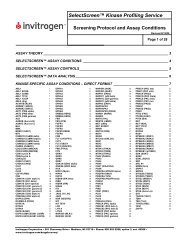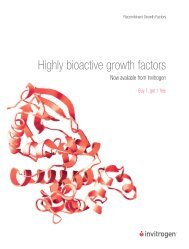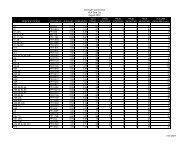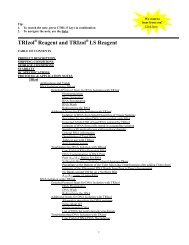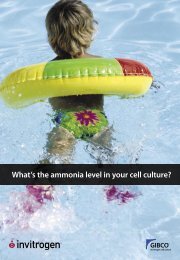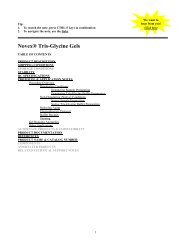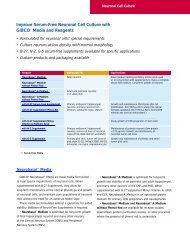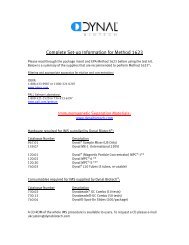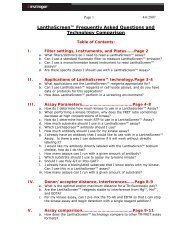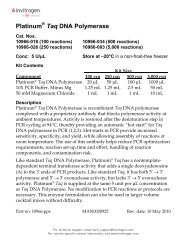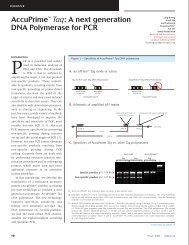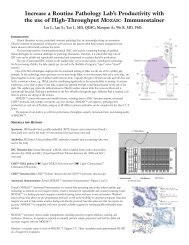Score winning cDNA yields with SuperScript III RT - Invitrogen
Score winning cDNA yields with SuperScript III RT - Invitrogen
Score winning cDNA yields with SuperScript III RT - Invitrogen
You also want an ePaper? Increase the reach of your titles
YUMPU automatically turns print PDFs into web optimized ePapers that Google loves.
<strong>Score</strong> <strong>winning</strong> <strong>cDNA</strong> <strong>yields</strong><br />
<strong>with</strong> <strong>SuperScript</strong> <strong>III</strong> <strong>RT</strong><br />
<strong>SuperScript</strong> <strong>III</strong> Reverse Transcriptase<br />
<strong>SuperScript</strong> <strong>III</strong> offers:<br />
• Higher <strong>cDNA</strong> <strong>yields</strong><br />
• Higher thermal stability<br />
• Longer half-life<br />
...than any other <strong>RT</strong><br />
you could use
Announcing <strong>SuperScript</strong> TM<br />
Reverse Transcriptase<br />
How could we possibly improve on <strong>SuperScript</strong> II Reverse Transcriptase?<br />
After all, more researchers all over the world depend on <strong>SuperScript</strong> than any<br />
other Reverse Transcriptase. Well, we did it. Higher thermostability. Longer half-<br />
life. The one Reverse Transcriptase you trust is now even more reliable. Get<br />
full-length <strong>cDNA</strong> and higher sensitivity. Perform <strong>RT</strong> at higher temperatures and<br />
get even higher <strong>yields</strong>. Whether you’re cloning, analyzing a single gene, or monitoring expression of<br />
every gene, <strong>SuperScript</strong> <strong>III</strong> <strong>RT</strong> will move your research forward even faster.<br />
<strong>SuperScript</strong> TM<br />
<strong>SuperScript</strong> <strong>III</strong> reverse transcriptase (<strong>RT</strong>) 138 , a point -<br />
mutant of <strong>SuperScript</strong> II <strong>RT</strong>5 , provides increased thermal<br />
stability and higher <strong>yields</strong>. Like M-MLV <strong>RT</strong>, it’s a DNA<br />
polymerase that synthesizes a complementary DNA strand<br />
from single-stranded DNA, RNA, or an RNA:DNA hybrid.<br />
And like <strong>SuperScript</strong> II <strong>RT</strong>, it’s engineered to be RNase H- ,<br />
2<br />
improved<br />
Table 1 – <strong>SuperScript</strong> <strong>III</strong> features and benefits<br />
Feature Benefit<br />
delivering high <strong>yields</strong> and full-length <strong>cDNA</strong>. Compared to<br />
all other <strong>RT</strong>s, <strong>SuperScript</strong> <strong>III</strong> has full activity at 50˚C and<br />
an incredibly long half-life of 220 minutes. You’ll get even<br />
higher <strong>cDNA</strong> <strong>yields</strong> and you can work at higher<br />
temperatures for superior performance in all your <strong>RT</strong><br />
experiments (Table 1).<br />
Half-life of 220 minutes at 50˚C High <strong>cDNA</strong> <strong>yields</strong><br />
Thermal stability at 50˚C Reduced background <strong>with</strong> gene-specific primer<br />
Results <strong>with</strong> RNA secondary structure<br />
RNase H negative High <strong>cDNA</strong> <strong>yields</strong><br />
Full-length <strong>cDNA</strong> to 12 kb<br />
Routine detection from as low as 1.0 pg total RNA<br />
Increased units Can increase <strong>RT</strong> units <strong>with</strong>out inhibiting subsequent PCR (1).<br />
Use 1-10 µl of a 20 µl <strong>RT</strong> reaction for subsequent PCR.<br />
www.invitrogen.com
Increased half-life for higher <strong>yields</strong><br />
The longer half-life of <strong>SuperScript</strong> <strong>III</strong> <strong>RT</strong> gives you<br />
greater <strong>cDNA</strong> <strong>yields</strong>. At its optimal temperature of<br />
50˚C, <strong>SuperScript</strong> <strong>III</strong> <strong>RT</strong> has a half-life of 220<br />
minutes—that’s 35 times longer than <strong>SuperScript</strong> II<br />
Figure 1 – Half-life of <strong>SuperScript</strong> <strong>III</strong> <strong>RT</strong> and <strong>SuperScript</strong> II <strong>RT</strong> at 50˚C<br />
More <strong>cDNA</strong>, get the message<br />
<strong>SuperScript</strong> <strong>III</strong> <strong>RT</strong> generates more <strong>cDNA</strong> than any<br />
other <strong>RT</strong>. This includes <strong>cDNA</strong> from total RNA or a<br />
specific gene. To demonstrate, we compared <strong>cDNA</strong><br />
yield from various <strong>RT</strong>s (Figure 2). The results speak<br />
A<br />
<strong>cDNA</strong> synthesis (pmol)<br />
Figure 2 – <strong>SuperScript</strong> <strong>III</strong> <strong>RT</strong> generates the highest<br />
<strong>cDNA</strong> <strong>yields</strong> from total RNA<br />
1,200<br />
1,000<br />
800<br />
600<br />
400<br />
200<br />
0<br />
PowerScript <br />
StrataScript <br />
ImProm-II <br />
<strong>SuperScript</strong> <strong>III</strong><br />
<strong>SuperScript</strong> II<br />
45°C<br />
<strong>SuperScript</strong> <strong>III</strong> Reverse Transcriptase<br />
and 70 times longer than M-MLV <strong>RT</strong>. The longer<br />
half-life makes <strong>SuperScript</strong> <strong>III</strong> more robust (Figure<br />
1) and your experiments more dynamic.<br />
<strong>RT</strong> was incubated in 1X first-strand buffer at<br />
50˚C. Samples were taken at time points<br />
indicated and activity measured by unit assay.<br />
for themselves. It’s simple: for maximized <strong>cDNA</strong><br />
yield in library construction, array applications, or<br />
<strong>RT</strong>-PCR, use <strong>SuperScript</strong> <strong>III</strong> <strong>RT</strong> and make every<br />
message count.<br />
B<br />
6 kb<br />
4 kb<br />
2 kb<br />
M PowerScript<br />
StrataScript<br />
45°C<br />
ImProm-II<br />
<strong>SuperScript</strong> <strong>III</strong><br />
<strong>SuperScript</strong> II<br />
The <strong>cDNA</strong> synthesis reactions were<br />
performed in 20 µl <strong>with</strong> 20 µg HeLa<br />
total RNA, 0.5 µg of oligo(dT)25 and<br />
0.1 µl of a-32P-dCTP (10 µCi/µl).<br />
Competitive products followed the<br />
manufacturer’s recommended<br />
protocols. After the reaction mixtures<br />
were pre-incubated at 45°C for 2 min,<br />
1 µl of each <strong>RT</strong> (400 U for <strong>SuperScript</strong><br />
<strong>III</strong>) was added and incubated at 45°C<br />
for another 50 min. The reactions were<br />
stopped by adding 10 µl of 0.5 M EDTA.<br />
5 µl of each reaction was TCAprecipitated<br />
and dried on GF/C filters.<br />
A. The total <strong>cDNA</strong> synthesized was<br />
calculated by 32P counts.<br />
B. The rest of the samples were ethanol<br />
precipitated and electrophoresed on<br />
1.2% agarose gel. The dried gel was<br />
exposed on the film for 1 hour.<br />
www.invitrogen.com 3
Active at higher temperatures<br />
<strong>SuperScript</strong> <strong>III</strong> is active in a wide temperature range,<br />
making it more useful than any other <strong>RT</strong> you could select<br />
(Figure 3A & 3B). It’s fully active at 50˚C but can be used<br />
4<br />
from 45-55˚C (Figure 4). Incubation at higher temperature<br />
is important when using gene-specific primers (Figure 5)<br />
or tackling RNA <strong>with</strong> secondary structure (Figure 6).<br />
More full-length, first-strand <strong>cDNA</strong> <strong>with</strong> <strong>SuperScript</strong> TM<br />
Figure 3A – <strong>SuperScript</strong> <strong>III</strong> compared to <strong>SuperScript</strong> II and M-MLV<br />
kb<br />
9.5<br />
7.5<br />
4.4<br />
2.4<br />
1.4<br />
Figure 3B – <strong>SuperScript</strong> <strong>III</strong> outperforms other <strong>RT</strong>'s<br />
6 kb<br />
4 kb<br />
2 kb<br />
Figure 4 – Activity of <strong>SuperScript</strong> <strong>III</strong> <strong>RT</strong> at various temperatures<br />
2.4 kb (BF)<br />
<strong>SuperScript</strong> <strong>III</strong><br />
M 37˚ 42˚ 45˚ 50˚ 55˚<br />
<strong>SuperScript</strong> <strong>III</strong> StrataScript PowerScript ImProm-II Omniscript<br />
M 45˚ 50˚ 55˚ 45˚ 50˚ 55˚ 45˚ 50˚ 55˚ 45˚ 50˚ 55˚ 45˚ 50˚ 55˚<br />
www.invitrogen.com<br />
<strong>SuperScript</strong> II<br />
<strong>SuperScript</strong> II<br />
<strong>SuperScript</strong> <strong>III</strong><br />
M-MLV<br />
37˚ 42˚ 45˚ 50˚ 55˚ 37˚ 42˚ 45˚ 50˚ 55˚ M<br />
M 45˚ 50˚ 55˚ 60˚ 45˚ 50˚ 55˚ 60˚ M<br />
Targets<br />
9.5 kb<br />
7.5 kb<br />
4.4 kb<br />
2.4 kb<br />
1.4 kb<br />
<strong>III</strong> <strong>RT</strong><br />
An autoradiograph is shown of 32 P-labeled <strong>cDNA</strong><br />
synthesized from a mixture of 0.25 µg each of<br />
1.35 kb, 2.4 kb, 4.4 kb, 7.5 kb, and 9.5 kb <strong>with</strong><br />
200 units of each <strong>RT</strong> at various temperatures.<br />
Lane M is 32 P-labeled 1 kb DNA ladder.<br />
32 P-labeled <strong>cDNA</strong> was synthesized in 20 µl at<br />
temperatures indicated (˚C) for 50-60 min. from a<br />
mixture of 0.2 µg each of 1.4 kb, 2.4 kb, 4.4 kb,<br />
7.5 kb, and 9.5 kb poly(A)-tailed RNA and 0.5 µg<br />
oligo(dT) 25 using buffers and components<br />
supplied <strong>with</strong> each kit. 1 µl of each <strong>RT</strong> or 400 U of<br />
<strong>SuperScript</strong> <strong>III</strong> was added to pre-warmed reaction<br />
mixtures (hot start). The reactions were stopped<br />
by adding 10 µl 0.5 M EDTA. After ethanol<br />
precipitation, the 32 P-labeled <strong>cDNA</strong> products were<br />
loaded on 1.2% alkaline agarose gel. The dried gel<br />
was exposed on film for 2 hours.<br />
<strong>cDNA</strong> was synthesized in 20 µl for 50 minutes at<br />
temperatures indicated from 500 ng HeLa total RNA<br />
<strong>with</strong> oligo(dT) primer. 400 U <strong>SuperScript</strong> II or<br />
<strong>SuperScript</strong> <strong>III</strong> <strong>RT</strong> was added to pre-warmed<br />
reaction mixtures (hot start). 2 µl of <strong>cDNA</strong> was<br />
added to 50 µl PCR reaction containing primers for<br />
2.4 kb Human Β-Factor properdin (BF) gene.
<strong>SuperScript</strong> <strong>III</strong> Reverse Transcriptase<br />
Increased priming specificity <strong>with</strong> gene specific primer<br />
<strong>SuperScript</strong> <strong>III</strong> <strong>RT</strong>’s activity at higher temperatures<br />
allows you to use gene-specific primers <strong>with</strong> a high<br />
Tm, increasing specificity, reducing background, and<br />
Figure 5 – Increased specificity <strong>with</strong> various genes<br />
Dynein (12.3 kb)<br />
CH (9.3 kb)<br />
Pol ε (6.8 kb)<br />
RAD (5.6 kb)<br />
42°C 50°C 55°C<br />
Relax: GC-rich RNA is not a problem<br />
High temperatures relax RNA secondary structure;<br />
temperatures where <strong>SuperScript</strong> <strong>III</strong> is active when<br />
other <strong>RT</strong>s are not. Increasing the reaction<br />
temperature to 55˚C melts hairpin structures,<br />
allowing synthesis to proceed. To demonstrate,<br />
Figure 6 – High <strong>yields</strong> <strong>with</strong> GC-rich RNA and gene specific primer<br />
55˚C<br />
M<br />
512 bp<br />
414 bp<br />
344 bp<br />
225 bp<br />
199 bp<br />
generating higher yield of your specific product. Use<br />
<strong>SuperScript</strong> <strong>III</strong> <strong>RT</strong> at 55˚C to achieve maximum<br />
yield <strong>with</strong> GSPs (Figure 5).<br />
M<br />
<strong>cDNA</strong> was synthesized in 20 µl<br />
from 2 µg total rat brain RNA for<br />
the Dynein 12.3 kb gene (Oligo<br />
dT 20) or from 1 µg total HeLa<br />
RNA for the other targets (GSP)<br />
using 200 units of <strong>SuperScript</strong><br />
<strong>III</strong>, 50 min at 42°C, 50°C, or<br />
55°C. One tenth of each reaction<br />
was amplified <strong>with</strong> Platinum ® Taq<br />
DNA Polymerase High Fidelity.<br />
we performed <strong>RT</strong>-PCR on a region of 28S rRNA that<br />
is 84% GC-rich. <strong>SuperScript</strong> <strong>III</strong> <strong>RT</strong> performed<br />
brilliantly, processing through all regions <strong>with</strong> high<br />
yield and low background (Figure 6).<br />
<strong>cDNA</strong> was synthesized from 100 ng HeLa<br />
total RNA <strong>with</strong> gene-specific primer (GSP)<br />
and 200 U <strong>SuperScript</strong> <strong>III</strong> <strong>RT</strong> in 20 µl for<br />
50 minutes at 55˚C. 2 µl of <strong>cDNA</strong> was<br />
added to 50 µl PCR reaction containing<br />
primers for regions on 28S rRNA indicated<br />
and 1 U of Platinum® Taq DNA Polymerase<br />
High Fidelity, at 97˚C for 2 min., then 40<br />
cycles, at 97˚C for 30 sec., 60˚C for 30 sec.,<br />
and 68˚C for 1 min.<br />
www.invitrogen.com 5
Routine detection in 1.0 pg total RNA<br />
<strong>SuperScript</strong> <strong>III</strong> <strong>RT</strong> has high sensitivity to work <strong>with</strong><br />
small sample sizes. You can routinely detect genes from<br />
low inputs of total RNA down to 1.0 pg. Compared to<br />
other <strong>RT</strong>s, <strong>SuperScript</strong> <strong>III</strong> <strong>RT</strong> not only detects genes<br />
Starting total HeLa<br />
RNA (pg)<br />
6<br />
Figure 7 – <strong>SuperScript</strong> <strong>III</strong> <strong>RT</strong> generates highest yield <strong>with</strong> low input RNA<br />
Starting total HeLa<br />
RNA (pg)<br />
GAPDH (532 bp)<br />
GAPDH (532 bp)<br />
Clontech<br />
PowerScript <br />
1<br />
42°C – 50 min<br />
10 100<br />
Figure 8 – Effect of <strong>RT</strong> units and <strong>cDNA</strong> volume on PCR<br />
www.invitrogen.com<br />
M<br />
Qiagen<br />
Omniscript <br />
M<br />
<strong>SuperScript</strong><br />
50 U 200 U<br />
II<br />
Stratagene<br />
StrataScript 1<br />
42°C – 60 min<br />
10 100<br />
from low input RNA, it also produces the highest yield<br />
(Figure 7). Increased units or <strong>cDNA</strong> volume is not<br />
inhibiting to PCR (Figure 8).<br />
Promega ImProm-II <br />
<strong>RT</strong> System<br />
<strong>Invitrogen</strong><br />
<strong>SuperScript</strong> <strong>III</strong><br />
50°C – 50 min<br />
1 10 100<br />
M M<br />
37°C – 60 min<br />
42°C – 60 min<br />
50°C – 50 min<br />
1 10 100<br />
1 10 100<br />
1 10 100<br />
M M M M<br />
<strong>SuperScript</strong> <strong>III</strong><br />
50 U 200 U<br />
<strong>Invitrogen</strong><br />
<strong>SuperScript</strong> <strong>III</strong><br />
<strong>cDNA</strong> was synthesized from HeLa total RNA <strong>with</strong> oligo(dT) primer using buffer supplied <strong>with</strong> each <strong>RT</strong><br />
and recommended conditions (400 U of <strong>SuperScript</strong> <strong>III</strong> <strong>RT</strong>). 10% of <strong>cDNA</strong> reaction was added to 50 µl<br />
PCR reaction containing primers for 532 bp GAPDH gene and 2 U of Platinum® Taq DNA Polymerase, 40<br />
cycles, 1 min/kb.<br />
TSC (5.3 kb)<br />
<strong>cDNA</strong> was synthesized from 100 ng total HeLa RNA <strong>with</strong> oligo(dT) primers using <strong>SuperScript</strong> II at 45˚C or<br />
<strong>SuperScript</strong> <strong>III</strong> at 50˚C. One third (7 µl) of the 20 µl reaction was amplified in 50 µl <strong>with</strong> 1 unit of Platinum ®<br />
Taq DNA Polymerase High Fidelity at 94˚C for 2 min, then 35 cycles at 94˚C for 15 sec, 55˚C for 30 sec, and<br />
68˚C for 6 min. PCR was performed <strong>with</strong> primers for human tuberous sclerosis (TSC 5.3 kb).
Full-length <strong>cDNA</strong>, high <strong>yields</strong><br />
Generate full-length <strong>cDNA</strong> <strong>with</strong> high <strong>yields</strong> from mimimal<br />
starting material for gene analysis or cloning <strong>with</strong><br />
<strong>SuperScript</strong> <strong>III</strong> (Figure 9). At 200 U/µl, you can set up<br />
reactions for high-throughput or increase units to increase<br />
Figure 9 – <strong>SuperScript</strong> <strong>III</strong> <strong>RT</strong> generates highest yield <strong>with</strong> various-sized targets<br />
Starting total RNA (ng)<br />
Dynein (12.3 kb)<br />
fibrillin (9.4 kb)<br />
adenomatous polyposis (8.5 kb)<br />
DNA polymerase ε (6.8 kb)<br />
nuclear receptor coactivator (6.1 kb)<br />
guanine nuc. exchange factor (5.9 kb)<br />
vinculin (4.6 kb)<br />
transcription factor (3.6 kb)<br />
B-factor properdin (2.4 kb)<br />
GAPDH (532 bp)<br />
β-actin (353 bp)<br />
1X<br />
HML<br />
λHind<strong>III</strong> fragments<br />
0.01<br />
0.01 10<br />
yield. Compared to other <strong>RT</strong>s, <strong>SuperScript</strong> <strong>III</strong> <strong>RT</strong> not only<br />
generates the highest <strong>yields</strong>, but it was also able to generate<br />
the 9.4 kb fibrillin target (Figure 10).<br />
10 10 10 10 10 10 1000 1000 1000<br />
<strong>cDNA</strong> was synthesized from HeLa total RNA or rat total RNA for Dynein <strong>with</strong> oligo(dT) primer using<br />
400 U of <strong>SuperScript</strong> <strong>III</strong> <strong>RT</strong> at 50°C. 10% of <strong>cDNA</strong> reaction was added to 50 µl PCR reaction containing<br />
primers for each gene and 2 U of Platinum® Taq DNA Polymerase or 1 U of Platinum® Taq DNA<br />
Polymerase High Fidelity, 35 or 40 cycles, 1 min/kb.<br />
Figure 10 – <strong>SuperScript</strong> <strong>III</strong> <strong>RT</strong> outperforms the competition<br />
Starting total HeLa RNA (ng)<br />
fibrillin (9.4 kb)<br />
vinculin (4.6 kb)<br />
B-factor properdin (2.4 kb)<br />
cap binding protein (1.6 kb)<br />
1.5X<br />
LML<br />
Promega<br />
ImProm-II <strong>RT</strong> System<br />
42˚C, 60 min<br />
10 100 100 100<br />
<strong>Invitrogen</strong><br />
<strong>SuperScript</strong> <strong>Invitrogen</strong><br />
<strong>SuperScript</strong> II<br />
42˚C, 50 min<br />
10 100 100 100<br />
Qiagen<br />
Omniscript <strong>III</strong> <strong>RT</strong><br />
50˚C, 50 min<br />
10 100 100 100<br />
Stratagene<br />
StrataScript <strong>RT</strong><br />
37˚C, 60 min<br />
10 100 100 100<br />
Clontech<br />
PowerScript <strong>RT</strong><br />
42˚C, 60 min<br />
10 100 100 100<br />
<strong>RT</strong><br />
42˚C, 50 min<br />
10 100 100 100<br />
1.5X<br />
LML<br />
1.5X<br />
LML<br />
<strong>cDNA</strong> was synthesized from 10 ng HeLa total RNA for cap binding protein (1.6 kb) or 100 ng HeLa total<br />
RNA for B-factor properdin (2.4 kb), vinculin (4.6 kb), and fibrillin (9.4 kb) <strong>with</strong> oligo(dT) primer<br />
using buffer and recommended conditions supplied <strong>with</strong> each <strong>RT</strong> (400 U of <strong>SuperScript</strong> <strong>III</strong> <strong>RT</strong>). 10%<br />
of the <strong>cDNA</strong> reaction was added to a 50 µl PCR reaction containing primers for each gene and<br />
2 U Platinum® Taq DNA Polymerase or 1 U Platinum® Taq DNA Polymerase High Fidelity, 35 cycles,<br />
1 min/kb.<br />
λHind<strong>III</strong> fragments<br />
M<br />
9.4<br />
4.6<br />
2.4<br />
1.6<br />
www.invitrogen.com 7
Easily optimize reaction conditions<br />
You can optimize <strong>SuperScript</strong> <strong>III</strong> <strong>RT</strong> for specific<br />
applications to ensure the best results. We provide<br />
Table 2 – <strong>SuperScript</strong> <strong>III</strong> <strong>RT</strong> specifications<br />
<strong>SuperScript</strong> <strong>III</strong> at 200 U/µl to allow flexibility in<br />
experimental design (Table 2).<br />
Units To increase <strong>yields</strong>, use 2 µl, or 400 U. Increasing units does not inhibit subsequent<br />
PCR as <strong>with</strong> other RNase H minus <strong>RT</strong>s. Use 400 U when synthesizing long targets (≥5 kb) at high<br />
temperature (≥ 55˚C).<br />
<strong>cDNA</strong> Volume 1-10 µl of <strong>cDNA</strong> reaction can be used in 50 µl PCR reaction.<br />
Temperature Even though <strong>SuperScript</strong> <strong>III</strong> <strong>RT</strong> is fully active at 50˚C, you can obtain good results at 45˚C. You<br />
should increase the temperature to 55˚C when using a gene-specific primer or working <strong>with</strong> highly<br />
structured RNA.<br />
Buffer <strong>SuperScript</strong> <strong>III</strong> <strong>RT</strong> uses the same 5X first-strand buffer as <strong>SuperScript</strong> II <strong>RT</strong>,<br />
making it easy to switch. Buffer formulation: [250 mM Tris-HCI (pH 8.3), 375 mM KCI,15 mM MgCI2] Storage As a single polypeptide, <strong>SuperScript</strong> <strong>III</strong> is very stable. It is shipped on dry ice to ensure full activity<br />
upon arrival. While <strong>SuperScript</strong> <strong>III</strong> <strong>RT</strong> is stable at –80˚C and can be kept at 4°C overnight <strong>with</strong>out<br />
activity loss, we recommend storage at –20˚C.<br />
Stringent quality control to ensure your results<br />
Each lot of <strong>SuperScript</strong> <strong>III</strong> <strong>RT</strong> is stringently quality<br />
controlled. Tests include SDS-PAGE to analyze<br />
purity; contamination assays to confirm absence<br />
of endodeoxyribonuclease, 3´ and 5´<br />
Figure 11 - <strong>SuperScript</strong> <strong>III</strong> <strong>RT</strong> is RNase-free<br />
9.5 kb<br />
7.5 kb<br />
4.4 kb<br />
2.4 kb<br />
1.4 kb<br />
0.24 kb<br />
Lane 1 Lane 2 Lane 3 Lane 4 Lane 5 Lane 6 Lane 7 Lane 8<br />
exodeoxyribonuclease, and ribonuclease activities<br />
(Figure 11); and <strong>cDNA</strong> synthesis of 7.5-kb target<br />
to meet yield and length criteria.<br />
<strong>SuperScript</strong> <strong>III</strong> Reverse Transcriptase<br />
5 µg of 0.24-9.5 kb RNA ladder was incubated <strong>with</strong> 1000 units of<br />
<strong>SuperScript</strong> II and <strong>III</strong> at 37˚C for 30 min followed by phenol extraction,<br />
then analyzed on a 1.25% formaldehyde/agarose/EtBr gel. Lane 1 and<br />
2: RNA Ladder <strong>with</strong> RNase-free water kept on ice for 30 min. Lane 3<br />
and 4: RNA ladder <strong>with</strong> <strong>SuperScript</strong> storage buffer incubated at 37˚C<br />
for 30 min. Lane 5 and 6: RNA ladder <strong>with</strong> 1000 units <strong>SuperScript</strong> II<br />
incubated at 37˚C for 30 min followed by phenol extraction. Lane 7 and<br />
8: RNA ladder <strong>with</strong> 1000 units <strong>SuperScript</strong> <strong>III</strong> incubated at 37˚C for<br />
30 min followed by phenol extraction.<br />
www.invitrogen.com 8
Superior performance for every application<br />
<strong>SuperScript</strong> <strong>III</strong> lets you work at higher<br />
temperatures to get greater <strong>cDNA</strong> <strong>yields</strong> and<br />
reduced background <strong>with</strong> gene-specific primers.<br />
Whether you’re cloning, analysing a single gene or<br />
Try <strong>SuperScript</strong> TM<br />
<strong>III</strong> today<br />
<strong>SuperScript</strong> <strong>III</strong> Reverse Transcriptase<br />
studying expression profiles, <strong>SuperScript</strong> <strong>III</strong> <strong>RT</strong> will<br />
give you overall superior performance to move your<br />
research forward even faster. For more information,<br />
visit www.invitrogen.com/superscript<strong>III</strong> today.<br />
Maximize <strong>cDNA</strong> yield, increase specificity, and enhance the results in all your <strong>RT</strong> experiments.<br />
Call <strong>Invitrogen</strong> and order <strong>SuperScript</strong> <strong>III</strong> <strong>RT</strong> today.<br />
Product Quantity Cat. no.<br />
<strong>SuperScript</strong> <strong>III</strong> Reverse Transcriptase 10,000 U 18080-044<br />
Accessories<br />
Product Quantity Cat. no.<br />
100 mM dNTP Set 4 x 250 µmol 10297-117<br />
100 mM dNTP Set 4 x 25 µmol 10297-018<br />
100 mM dATP 25 µmol 10216-018<br />
100 mM dCTP 25 µmol 10217-016<br />
100 mM dGTP 25 µmol 10218-014<br />
100 mM dTTP 25 µmol 10219-012<br />
10 mM dNTP Mix 1ml 18427-088<br />
10 mM dNTP Mix 2.5 µmol 18427-013<br />
10 mM dATP 2.5 µmol 18255-018<br />
10 mM dCTP 2.5 µmol 18252-015<br />
10 mM dGTP 2.5 µmol 18254-011<br />
10 mM dTTP 2.5 µmol 18253-013<br />
Oligo (dT) 12-18 Primer 25 µg 18418-012<br />
5, 138 Products mentioned above are subject to Limited Use Label Licenses indicated by the <strong>SuperScript</strong> numbers. Please refer to the <strong>Invitrogen</strong> web site or catalogue for<br />
Limited Use Label Licenses corresponding to the numbers indicated.<br />
StrataScript is a trademark of Stratagene. Omniscript is a trademark of Qiagen. PowerScript is a trademark of Clontech. ImProm-II is a trademark of Promega. <strong>SuperScript</strong><br />
is a trademark of <strong>Invitrogen</strong>. Platinum® is a registered trademark of <strong>Invitrogen</strong>. For research use only. Not intended for any animal or human therapeutic or diagnostic use.<br />
Reference: 1. Huang, L. et al. (2000) Focus® 22:6.<br />
www.invitrogen.com 9
To order<br />
AUSTRIA<br />
<strong>Invitrogen</strong> GmbH<br />
Gebührenfreie Bestellungen:<br />
Tel: 0800 20 10 87<br />
Fax: 0800 21 63 17<br />
BELGIUM<br />
N.V. <strong>Invitrogen</strong> S.A.<br />
Free Phone Orders: 0800 14894<br />
Tel: 09 272 55 99<br />
Fax: 09 272 55 98<br />
DENMARK<br />
<strong>Invitrogen</strong> A/S<br />
Frikaldsnr. ordre: 80 30 17 40<br />
Tel: 43 99 43 44<br />
Fax: 43 99 43 45<br />
Euro Tech-Line SM Numbers<br />
Austria: 0800 21 59 35<br />
Belgium: 0800 16369<br />
Denmark: 80 30 17 38<br />
France: 0800 91 83 92<br />
Germany: 0800 1 81 54 50<br />
FRANCE<br />
<strong>Invitrogen</strong> SARL<br />
Téléphone vert commandes:<br />
0800 23 20 79<br />
Fax vert commandes:<br />
0800 13 58 13<br />
Tél: 01 34 32 31 00<br />
Fax: 01 30 37 50 07<br />
GERMANY<br />
<strong>Invitrogen</strong> GmbH<br />
Gebührenfreie Bestellungen:<br />
Tel: 0800 083 09 02<br />
Fax: 0800 083 34 35<br />
ITALY<br />
<strong>Invitrogen</strong> S.R.L<br />
Free Fax Orders: 800 302 505<br />
Tel: 02 98 22 201<br />
Fax: 02 98 24 15 17<br />
Italy: 800 016 289<br />
Netherlands: 0800 099 8882<br />
Norway: 800 11744<br />
Portugal: 0800 844 319<br />
Spain: 900 964 463<br />
P127<br />
THE NETHERLANDS<br />
<strong>Invitrogen</strong><br />
Gratis Telefoon (Orders):<br />
0800 099 3310<br />
Gratis Fax (Orders):<br />
0800 023 4212<br />
NORWAY<br />
<strong>Invitrogen</strong> AS<br />
Free Phone: 00800 5345 5345<br />
Tel: 22 83 16 00<br />
Free Fax: 00800 7890 7890<br />
SPAIN/PO<strong>RT</strong>UGAL<br />
<strong>Invitrogen</strong> S.A<br />
Pedidos Tel. (Gratuito):<br />
900 181 461<br />
Pedidos Fax. (Gratuito):<br />
900 181 460<br />
Tel: 93 479 69 50<br />
Fax: 93 479 69 55<br />
Sweden: 020 79 84 15<br />
Switzerland: 0800 83 78 64<br />
UK: 0800 838 380<br />
Should you require any technical information<br />
please e-mail us at: eurotech@invitrogen.com<br />
www.invitrogen.com<br />
<strong>SuperScript</strong> <strong>III</strong> Reverse Transcriptase<br />
SWEDEN<br />
<strong>Invitrogen</strong> AB<br />
Ordertelefon: 020 26 34 52<br />
Tel: 08 630 73 20<br />
Fax: 08 732 44 93<br />
SWITZERLAND<br />
<strong>Invitrogen</strong> AG<br />
Free Phone Orders:<br />
0800 84 88 00<br />
Free Fax Orders:<br />
0800 87 68 00<br />
UNITED KINGDOM<br />
<strong>Invitrogen</strong> Ltd<br />
Free Phone Orders:<br />
0800 269 210<br />
Free Fax Orders:<br />
0800 243 485<br />
Tel: 0141 814 6100<br />
Fax: 0141 814 6260<br />
Printed in the UK. ©2003 <strong>Invitrogen</strong> Corporation. Reproduction forbidden <strong>with</strong>out permission.



